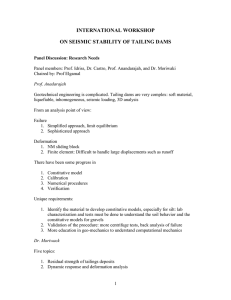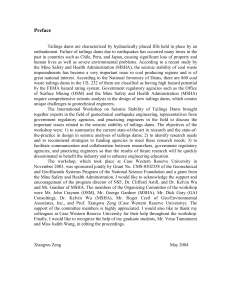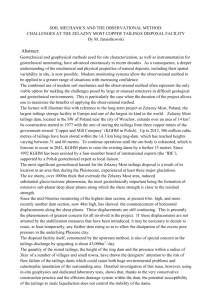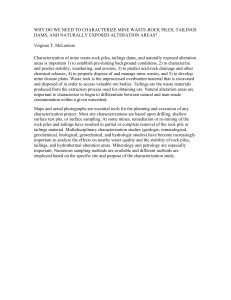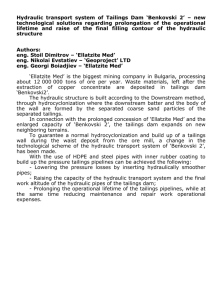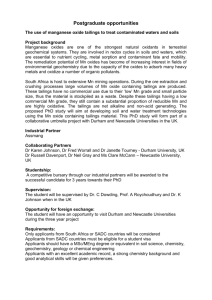INTERNATIONAL WORKSHOP ON SEISMIC STABILITY OF TAILING DAMS
advertisement
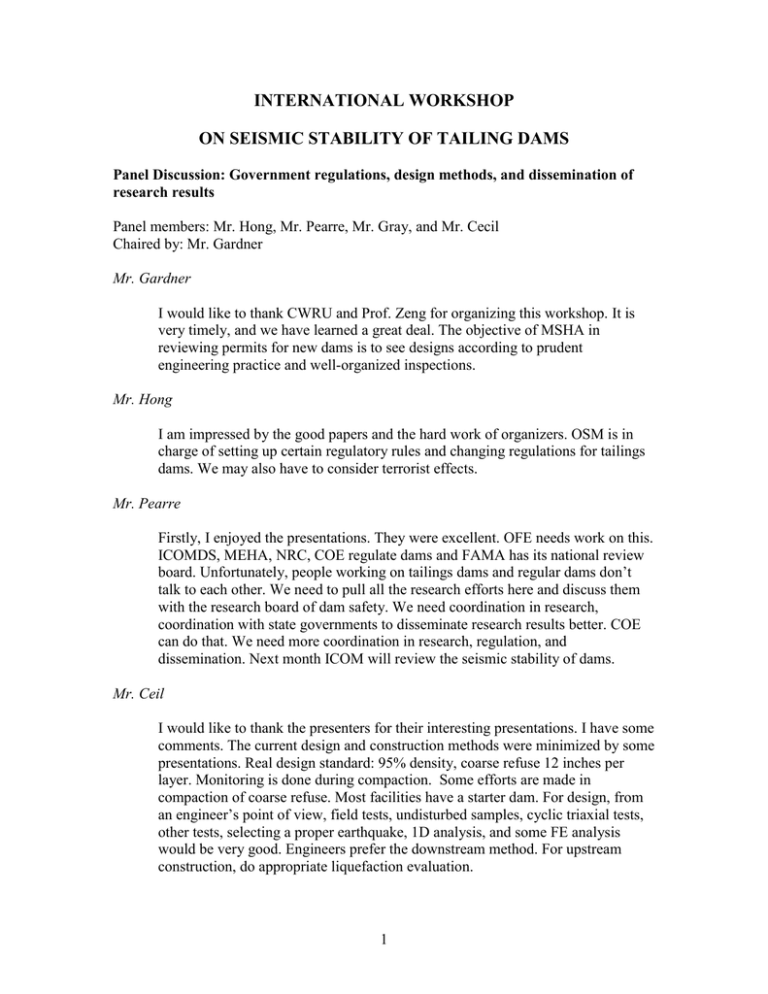
INTERNATIONAL WORKSHOP ON SEISMIC STABILITY OF TAILING DAMS Panel Discussion: Government regulations, design methods, and dissemination of research results Panel members: Mr. Hong, Mr. Pearre, Mr. Gray, and Mr. Cecil Chaired by: Mr. Gardner Mr. Gardner I would like to thank CWRU and Prof. Zeng for organizing this workshop. It is very timely, and we have learned a great deal. The objective of MSHA in reviewing permits for new dams is to see designs according to prudent engineering practice and well-organized inspections. Mr. Hong I am impressed by the good papers and the hard work of organizers. OSM is in charge of setting up certain regulatory rules and changing regulations for tailings dams. We may also have to consider terrorist effects. Mr. Pearre Firstly, I enjoyed the presentations. They were excellent. OFE needs work on this. ICOMDS, MEHA, NRC, COE regulate dams and FAMA has its national review board. Unfortunately, people working on tailings dams and regular dams don’t talk to each other. We need to pull all the research efforts here and discuss them with the research board of dam safety. We need coordination in research, coordination with state governments to disseminate research results better. COE can do that. We need more coordination in research, regulation, and dissemination. Next month ICOM will review the seismic stability of dams. Mr. Ceil I would like to thank the presenters for their interesting presentations. I have some comments. The current design and construction methods were minimized by some presentations. Real design standard: 95% density, coarse refuse 12 inches per layer. Monitoring is done during compaction. Some efforts are made in compaction of coarse refuse. Most facilities have a starter dam. For design, from an engineer’s point of view, field tests, undisturbed samples, cyclic triaxial tests, other tests, selecting a proper earthquake, 1D analysis, and some FE analysis would be very good. Engineers prefer the downstream method. For upstream construction, do appropriate liquefaction evaluation. 1 Develop consistent methods for seismic evaluation. We need more sharing of data. Develop different ways of designs. Conduct more CPT tests. More instrumentation is recommended. It is important for engineers and regulators to learn the new techniques. Mr. Gray It is a pleasure for me to be here. For the analysis of tailing dams under seismic loading: 1. Techniques are difficult: earthquake characterization (frequency, intensity, duration, etc.), evaluating properties of tailings, liquefaction potential of fines. 2. Economical and human difficulties. Owners do not want the tailings. For large companies, a failure affects profit, but small companies do not appreciate it. They consider engineering design as a commodity. Shortly after the Buffalo Creek failure, we found some shocking quality of work. There was an embankment with a factor of safety less than 1.0 without any explanations. In the work on dams, quality has improved measurably. For a recent example of a tailings dam failure, I explored the work done over years. In spite of the regulations, owners do not follow them. These dams are designed to retain something. The regulations have to be followed. 3. I suggest to agencies to develop detailed guidelines for design. Simplified enough guidelines. They should also organize some series of short courses to educate designers and regulators. Question For tailings dam design how does one evaluate the effect of increased excess pore pressure on a stability analysis? Prof. Idriss There are coupled or de-coupled analyses (the choice between the two depends on whether the effects of shaking and gravity are considered at the same time). A coupled analysis is complicated and needs a lot of parameters. A decoupled analysis looks at earthquake effects only during shaking and then looks at the gravity effect (dissipation of excess pore pressure) after an earthquake. Ideally, a stability analysis should be looked at as a coupled problem. However, VELACS shows no procedure can do it all. We need to continue the efforts in developing complex procedures. There are several schools of thoughts. Education and communication are required. We need to develop something simpler for designers to use. A de-coupled approach is not simple either, but it is realistic. Pseudo-static analysis is useless, as it has no understanding of soil properties. 2 Dr. Castro A decoupled analysis still has its role. The area which we are lacking is in the fundamental properties of tailings. Sometimes the strength is off by a factor of 2 or 3. This is a source of considerable error. We need to judge the output from an analysis. Measuring properties properly is very important. Question For steady state strength, a vane shear test is the most appropriate test. How quickly should we perform the test? Dr. Castro There is a paper on it for a Chilean case. Peak undrained strength is there even with excess pore pressure. For a number of structures, when using peak strength in the analysis, the dam is safe. When using residual strength, it is not. Question How should one define a lower bound residual strength? Dr. Castro The answer is also in the paper, but it is not generalized for all tailings. With that kind of strain, most dams would fail. Prof. Idriss The good thing about a vane shear test is that it is undrained. You can get the residual strength. If the test is done too slowly, you get the drained strength. No matter what the steady state strength is, you have to pass the peak strength. Experience in Anchorage shows that you can pass the peak strength with little moment. Prof. Elgamal Every time there is assessment about the factor of safety, the dynamic analysis is based on the static state. One needs to know the static state. It is useful to improve the static monitoring, need to look it very carefully. There are examples of that. Another point: steady state strength is a global parameter. From lab tests and insitu states, to give the number as so and so is not right. Once an earthquake occurs, many local conditions change. Then the steady state strength is useful. Insitu testing methods and computational methods can help. 3 Mr. Gardner Tailing dams are different from traditional dams. You have silty soil, sandy soil, soil behavior under high confining pressures, etc. At high confining pressures, are the tailings contractive and dilative? Dr. Castro Undrained strength at high confining pressures and lower void ratio. For sand, the line is more flat. We don’t have data for high pressure conditions. Prof. Idriss 1. At deep locations, the confining pressure is important for resistance to cyclic loading. 2. We do not know much about the residual strength of soil with high silt content. Comment from a participant 200 ft or 50 ft overburden is important. Depending on the geometry, it may or may not translate into flow. 200ft confining pressure is not that high since the specific gravity Gs is low. Sloped ground may lead to lower confining pressures. Question For the shear-vane test, is the residual strength at high strain its steady-state strength? Dr. Castro They should be close, if it is undrained. Disturbances can change the steady-state strength. Comment from a participant on depth Deeper than 50ft, refuse can achieve 90% proctor density. Government regulatory policies need to be consistent. There is a large gap in the regulatory policies. For example, in slope stability analysis, regulations require: Static SF=1.5 Dynamic SF= 1.2 What method should be used for the above factor of safety? 4 Comment from a participant The problem is to apply research results carried out at a different place to a tailings dam. Regulations are there but not enough information is provided. Federal funding agencies for research on tailings dams are gone. Prof. Idriss The electronics industry supports its research. Maybe the coal industry can do something like that. Mr. Gardner Regulation in the coal industry is stricter than that in metal mining. The tailings dams are better designed. There needs to be a mechanism to recognize the importance of research and to let the industry support research. Prof. Idriss In California, industries in the 70s did not do seismic analysis unless regulation required it. That was a problem that needed to be addressed. The 1971 San Fernando failure changed the regulations, and now seismic design is mandatory. Comment from a participant Regulations are there. Engineers just need more information. Prof. Elgamal In California, there are test beds for seismic research. Is it possible to have such a case for tailings dam? Mr. Gardner For an earth dam, cyclic triaxial tests are often conducted to evaluate the liquefaction of soil. The definition of liquefaction is sometimes defined as peak to peak strain of 5%. Any comments on that? Dr. Castro Tests should be conducted to see how soils behave, which is not defined by strain. They are used to see the final effect such as deformation. 5% peak-to-peak strain is useless. We should study how much deformation occurs, whether we are losing the strength we rely on for stability, and how much deformation is tolerable. There are differences between tailings and traditional soil. Do not apply the knowledge for soils to fine refuse. 5 Prof. Idriss For loose sand it is 2.5% peak-to-peak strain. For dense sand, strain is not defined. Numerical analysis is needed to evaluate the importance of large strain. Prof. Li We need to conduct some traditional tests to find how different the tailings materials are from traditional soils. 6
